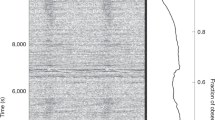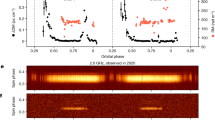Abstract
It is thought that neutron stars in low-mass binary systems can accrete matter and angular momentum from the companion star and be spun-up to millisecond rotational periods1,2,3. During the accretion stage, the system is called a low-mass X-ray binary, and bright X-ray emission is observed. When the rate of mass transfer decreases in the later evolutionary stages, these binaries host a radio millisecond pulsar4,5 whose emission is powered by the neutron star’s rotating magnetic field6. This evolutionary model is supported by the detection of millisecond X-ray pulsations from several accreting neutron stars7,8 and also by the evidence for a past accretion disc in a rotation-powered millisecond pulsar9. It has been proposed that a rotation-powered pulsar may temporarily switch on10,11,12 during periods of low mass inflow13 in some such systems. Only indirect evidence for this transition has hitherto been observed14,15,16,17,18. Here we report observations of accretion-powered, millisecond X-ray pulsations from a neutron star previously seen as a rotation-powered radio pulsar. Within a few days after a month-long X-ray outburst, radio pulses were again detected. This not only shows the evolutionary link between accretion and rotation-powered millisecond pulsars, but also that some systems can swing between the two states on very short timescales.
This is a preview of subscription content, access via your institution
Access options
Subscribe to this journal
Receive 51 print issues and online access
$199.00 per year
only $3.90 per issue
Buy this article
- Purchase on Springer Link
- Instant access to full article PDF
Prices may be subject to local taxes which are calculated during checkout



Similar content being viewed by others
References
Bisnovatyi-Kogan, G. S. & Komberg, B. V. Pulsars and close binary systems. Sov. Astron. 18, 217–221 (1974)
Alpar, M. A., Cheng, A. F., Ruderman, M. A. & Shaham, J. A new class of radio pulsars. Nature 300, 728–730 (1982)
Radhakrishnan, V. & Srinivasan, G. On the origin of the recently discovered ultra-rapid pulsar. Curr. Sci. India 51, 1096–1099 (1982)
Backer, D. C., Kulkarni, S. R., Heiles, C., Davis, M. M. & Goss, W. M. A millisecond pulsar. Nature 300, 615–618 (1982)
Ruderman, M., Shaham, J. & Tavani, M. Accretion turnoff and rapid evaporation of very light secondaries in low-mass X-ray binaries. Astrophys. J. 336, 507–518 (1989)
Pacini, F. Energy emission from a neutron star. Nature 216, 567–568 (1967)
Wijnands, R. & van der Klis, M. A millisecond pulsar in an X-ray binary system. Nature 394, 344–346 (1998)
Chakrabarty, D. & Morgan, E. H. The two-hour orbit of a binary millisecond X-ray pulsar. Nature 394, 346–348 (1998)
Archibald, A. M. et al. A radio pulsar/X-ray binary link. Science 324, 1411–1414 (2009)
Stella, L., Campana, S., Colpi, M., Mereghetti, S. & Tavani, M. Do quiescent soft X-ray transients contain millisecond radio pulsars? Astrophys. J. 423, L47–L50 (1994)
Campana, S., Colpi, M., Mereghetti, S., Stella, L. & Tavani, M. The neutron stars of soft X-ray transients. Astron. Astrophys. Rev. 8, 279–316 (1998)
Burderi, L. et al. Where may ultrafast rotating neutron stars be hidden? Astrophys. J. 560, L71–L74 (2001)
van Paradijs, J. On the accretion instability in soft X-ray transients. Astrophys. J. 464, L139–L141 (1996)
Burderi, L., Di Salvo, T., D’Antona, F., Robba, N. R. & Testa, V. The optical counterpart to SAX J1808.4–3658 in quiescence: evidence of an active radio pulsar? Astron. Astrophys. 404, L43–L46 (2003)
Hartman, J. M. et al. The long-term evolution of the spin, pulse shape, and orbit of the accretion-powered millisecond pulsar SAX J1808.4–3658. Astrophys. J. 675, 1468–1486 (2008)
Di Salvo, T., Burderi, L., Riggio, A., Papitto, A. & Menna, M. T. Orbital evolution of an accreting millisecond pulsar: witnessing the banquet of a hidden black widow? Mon. Not. R. Astron. Soc. 389, 1851–1857 (2008)
Patruno, A. The accreting millisecond X-ray pulsar IGR J00291+5934: evidence for a long timescale spin evolution. Astrophys. J. 722, 909–918 (2010)
Papitto, A. et al. Spin down during quiescence of the fastest known accretion-powered pulsar. Astron. Astrophys. 528, A55 (2011)
Lewin, W. H. G., van Paradijs, J. & Taam, R. E. X-Ray bursts. Space Sci. Rev. 62, 223–389 (1993)
Bégin, S. A Search for Fast Pulsars in Globular Clusters. MSc thesis, Faculty of Graduate Studies (Physics), Univ. British Columbia. (2006)
Manchester, R. N., Hobbs, G. B., Teoh, A. & Hobbs, M. The Australia Telescope National Facility Pulsar Catalogue. Astron. J. 129, 1993–2006 (2005)
Bogdanov, S. et al. Chandra X-ray observations of 12 millisecond pulsars in the globular cluster M28. Astrophys. J. 730, 81 (2011)
Papitto, A. et al. XMM-Newton detects a relativistically broadened iron line in the spectrum of the ms X-ray pulsar SAX J1808.4–3658. Astron. Astrophys. 493, L39–L43 (2009)
Chakrabarty, D. et al. Nuclear-powered millisecond pulsars and the maximum spin frequency of neutron stars. Nature 424, 42–44 (2003)
Gaensler, B. M., Stappers, B. W. & Getts, T. J. Transient radio emission from SAX J1808.4–3658. Astrophys. J. 522, L117–L119 (1999)
Bhattacharya, D. & van den Heuvel, E. P. J. Formation and evolution of binary and millisecond radio pulsars. Phys. Rep. 203, 1–124 (1991)
Burgay, M. et al. A search for pulsars in quiescent soft X-ray transients. I. Astrophys. J. 589, 902–910 (2003)
Fruchter, A. S., Stinebring, D. R. & Taylor, J. H. A millisecond pulsar in an eclipsing binary. Nature 333, 237–239 (1988)
Leahy, D. A., Elsner, R. F. & Weisskopf, M. C. On searches for periodic pulsed emission—the Rayleigh test compared to epoch folding. Astrophys. J. 272, 256–258 (1983)
Harris, W. E. A catalog of parameters for globular clusters in the Milky Way. Astron. J. 112, 1487–1488 (1996)
Acknowledgements
This letter is based on ToO observations made with XMM-Newton, Chandra, INTEGRAL, Swift, ATCA, WSRT, GBT and PKS. We thank the respective directors and operation teams for their support. Work was done in the framework of grants AYA2012-39303, SGR2009-811 and iLINK2011-0303, and with the support of CEA/Irfu, IN2P3/CNRS and CNES (France), INAF (Italy), NWO (The Netherlands) and NSERC (Canada). A.Pa. is supported by a Juan de la Cierva Research Fellowship. A.R. acknowledges Sardinia Regional Government for financial support (P.O.R. Sardegna ESF 2007-13). D.F.T. was additionally supported by a Friedrich Wilhelm Bessel Award of the Alexander von Humboldt Foundation. L.P. thanks the Société Académique de Genève and the Swiss Society for Astrophysics and Astronomy. We acknowledge the use of data supplied by the UK Swift Science Data Centre at the University of Leicester. A.Pa. thanks S. Giannetti, D. Lai, R. V. E. Lovelace, M. M. Romanova and T. Tauris for discussions, and S. D. Wolf for operational support.
Author information
Authors and Affiliations
Contributions
A.Pa., C.F. and E.B. collected and analysed XMM-Newton data. A.Pa. and C.F. detected the pulsar in XMM-Newton data and derived its orbital solution. A.Pa. discovered the equivalence of its parameters with a radio pulsar, the thermonuclear burst and the burst oscillations. N.R. analysed Chandra data, detecting the X-ray quiescent counterpart of the source and past accretion events. L.P., M.H.W., M.D.F. and G.F.W. analysed ATCA data. E.B., S.C., P.R., A.Pa. and A.R. analysed Swift data. E.B. and C.F. analysed INTEGRAL data. J.W.T.H. analysed WSRT data. M.B. and J.M.S. analysed PKS data. J.W.T.H., S.M.R., A.Po., I.H.S. and P.C.C.F. analysed GBT data. A.R. provided software tools. A.Pa., N.R. and J.W.T.H. wrote the manuscript, with significant contribution by all the authors in interpreting the results and editing of the manuscript.
Corresponding author
Ethics declarations
Competing interests
The authors declare no competing financial interests.
Supplementary information
Supplementary Information
This file contains Supplementary Figures 1-6, Supplementary Text and Data 1-8, Supplementary Tables 1-3 and additional references. (PDF 663 kb)
Rights and permissions
About this article
Cite this article
Papitto, A., Ferrigno, C., Bozzo, E. et al. Swings between rotation and accretion power in a binary millisecond pulsar. Nature 501, 517–520 (2013). https://doi.org/10.1038/nature12470
Received:
Accepted:
Published:
Issue Date:
DOI: https://doi.org/10.1038/nature12470
This article is cited by
-
X-ray astronomy comes of age
Nature (2022)
Comments
By submitting a comment you agree to abide by our Terms and Community Guidelines. If you find something abusive or that does not comply with our terms or guidelines please flag it as inappropriate.



